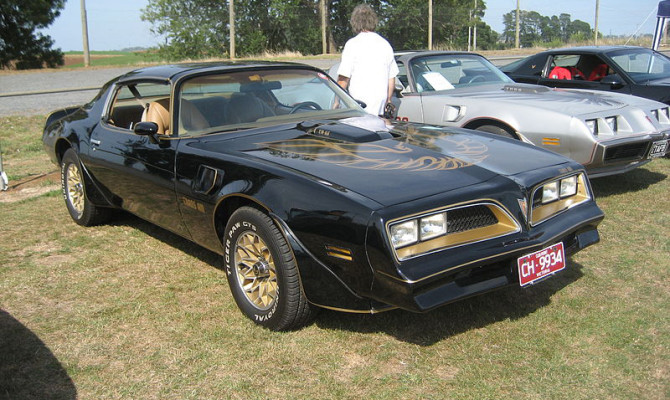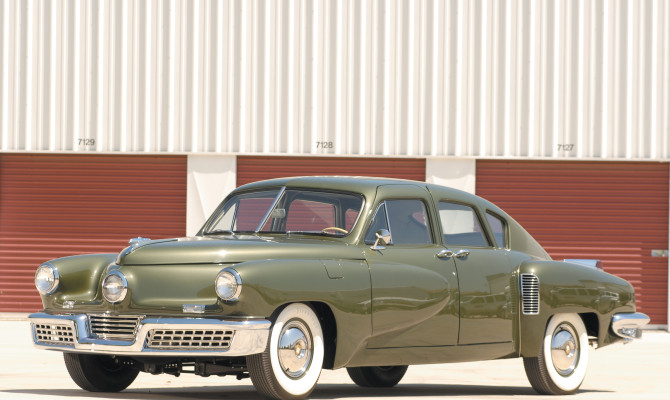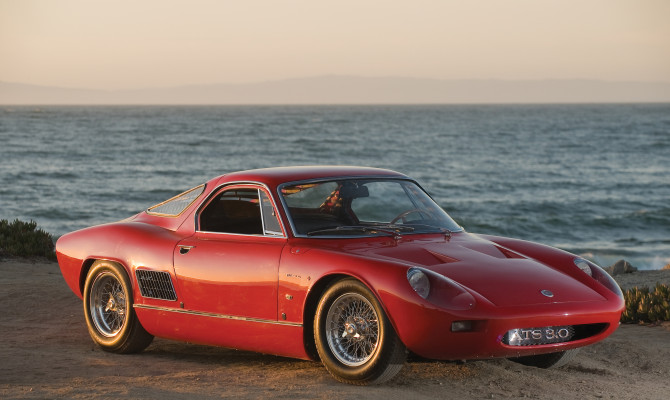by Grant Stoecker
The ‘Malaise Era’ was the antithesis of the muscle car heyday that existed merely a year before its start in 1973.
It was a dark period characterized best by underwhelming engines, EPA restrictions, and questionable styling. In the Malaise Era you could run your new Cobra through the gears without raising the attention of local law enforcement. The Malaise era wasn’t without hope, and the era saw production of a few diamonds in the rough. Here are our picks.
1. 1977 Pontiac Firebird Trans-Am Special Edition
Call it the Burt Reynolds Effect, but the 1977 Trans-Am is still a kick-ass ride. Featured in 1977’s top grossing film, Smokey and the Bandit, the black and gold Trans-Am had as much star power as the moustachioed Reynolds.
The power for the T/A came from a 6.6 litre V8, producing a disappointing 200 horses for 1977, a far cry years prior. It didn’t seem to matter as you cruised down main street, however, T-Tops in the trunk and blasting Journey through the 8-track. The menacing looks of the Trans Am seemed to be more than supple to erase any memory of the days of muscle car past, as other drivers stared in awe from the seats of the latest econo-box.
2. 1981-83 DeLorean DMC-12
The DMC-12 was the car from the future that no one had asked for, but everyone wanted.
Built by an automotive dream team consisting of John DeLorean, Colin Chapman, and Giorgetto Giugiaro, the DMC-12 was built to be a futuristic luxury coupe with a 200 horsepower Wankel rotary engine and price of $12,000. Execution of the concept missed the mark, and the production DMC-12 drew its underwhelming 130 horsepower from a Renault 6, and was sold for $36,000.
Despite this, the DeLorean secured its spot in the hearts of people around the globe as Doc Brown’s time machine in the 80’s mega-franchise, Back to the Future. If only they had come stock with the flux capacitor.
3. 1983-86 Audi Quattro
Germany continued to make fast cars throughout the malaise era, such as the BMW M1 and Porsche 930, but Audi created a completely new segment of car with the introduction of its all-wheel drive performance car, the Audi Quattro.
The Quattro was originally introduced to the European marketplace in 1980, but did not make its way stateside until 1983. With power from its turbocharged five-cylinder going to all four wheels, the Audi Quattro became a rally car legend, and the production models looked the part with its noticeable fender flares, Audi graphics, and BBS alloy wheels. The car was a head of its time, and only 664 were ever sold in the US before Audi discontinued it stateside in 1987.
4. 1974-76 Bricklin SV-1
Canada’s primary contribution to the malaise era was the brainchild of American millionaire Malcolm Bricklin, who dreamt of making the world’s safest sport car, naming his creation the Safety Vehicle One, or SV-1. The SV-1 had a smattering of safety features ranging from an integrated roll cage to safety bumpers, and even lacked an ashtray to discourage drivers from smoking. The Bricklin was powered by an AMC or Ford V8, and was rated favorably at the time against its competitor, the Corvette. Despite initial reviews, the car was notorious for poor build quality, and the engine was prone to overheating due to its small radiator. Bricklin went into receivership in 1976, and the SV-1 was dead in the water.
5. 1987 Buick Grand National/GNX
The Buick Grand National was not your grandfather’s Buick. Often referred to as Darth Vader’s car due to its all black paint scheme, the Buick Grand National was powered by a Turbocharged V6, and was rated for only 245 horsepower. The Grand National Experimental, or GNX, was the baddest of the Grand Nationals, and after rolling off the production line, it was sent to the mad scientists over at McLaren Performance, who modified the engine to be able to run 0 to 100 m/h in a mere 4.3 seconds, a figure impressive by modern standards.
Grant Stoecker writes for Hagerty Insurance. Hagerty is the world’s leading specialist provider of classic car and boat insurance. Learn more at hagerty.ca
Hundred-year anniversaries in the automotive world are nearly as common as new reality TV shows (General Motors, Aston Martin and Alfa Romeo all turned 100 recently).
The car companies on this list weren’t as fortunate…
Davis (1947-48)
The Davis Car Company was founded in 1947 in Van Nuys, Calif., by entrepreneur Gary Davis, who for reasons best known to himself decided that America was ready for a tiny three-wheeled car with just 47 hp. Like the next car company on the list, Davis also took advantage of a surplus WW2 defense plant as his base of operations. With the fast-developing freeway culture in Southern California (the car’s introduction coincided with the adoption of a comprehensive freeway plan for the region), there was little demand for an underpowered three-wheeler wholly unsuited for freeway use. The company collapsed in 1948 under the weight of unpaid employees and suppliers. The founder was jailed for fraud.
Tucker (1948)
The Tucker story is probably the least comical of the bunch. Preston Tucker conceived a car with some truly innovative safety and performance features. Its merits were considerable and it deserved to succeed. Sadly, it wasn’t to be. Negative publicity — and, many say, a conspiracy among the legacy automakers — coupled with an SEC investigation put a quick end to Tucker. About 50 cars were built in an ex-defense plant in Chicago before Tucker folded in early 1949, and 1948 was the only model year for the car known as the Tucker 48. The entire sad saga was chronicled in the 1988 Francis Ford Coppola film “Tucker: A Man and His Dreams.” Today, most of the cars survive as cherished museum pieces and in private collections. Tuckers have brought as much as $2 million at classic car auctions.
Bricklin (1974-76)
Malcolm Bricklin just can’t stay out of the automotive industry. An early investor in Subaru of North America, he sold his stake to finance his dream — a “safety” sports car bearing his name. Sports cars and safety have never gone hand in hand, and some would even argue that an element of danger is part of their raffish charm. Not surprisingly, there was little demand for a “safe” sports car offered in colors like Safety Orange, Safety Green, Safety White and Safety Suntan (an odd, fleshy beige color). Safety Red was the only conventional color. Bricklins were built by a largely inexperienced workforce in New Brunswick, Canada, from 1974-76. Poor quality control — the gullwing doors were famous for trapping occupants inside — and low demand sunk Bricklin, leaving the Canadian government to foot the bills. Little was learned from the debacle. (See: DeLorean.) Bricklin went on to bring to America the much-reviled Yugo.
DeLorean (1981-83)
Ex-GM superstar John Z. DeLorean stole a page from the Bricklin playbook. Just five years later, he convinced another gullible government (this time, the UK Labour Party) to build a factory in another high unemployment area (troubled Belfast, Northern Ireland) to construct another gullwing-door sports car named after its founder. Its styling, the work of the great Giorgetto Giugiaro of famed Ital Design, was a far more professional job than the Bricklin, and the DeLorean DMC-12 had a number of striking features, including its high-end appliance-like stainless steel body panels and unique doors. Sadly, the Renault-Peugeot-Volvo V6 left the car woefully underpowered and at a price point that put it into competition with faster and more established cars. The whole enterprise sank under debts guaranteed by the British government.
ATS (1962-63)
To say that Enzo Ferrari was imperious would be akin to calling Steve Jobs “somewhat clever.” When Ferrari’s wife began to meddle in his company, a number of key staffers could stand it no more and called it quits in what became known as “The Ferrari Mutiny.” They immediately started a new Italian sports car company known as ATS, the one and only product being the advanced and beautiful 2500 Coupe. Although ATS avoided the jinx of being named for the founder, the company still quickly foundered. The few surviving 2500 Coupes are worth about $1 million each.
*Rob Sass is the vice-president of content for Hagerty Insurance. Hagerty is the world’s leading specialist provider of classic car and boat insurance. Learn more at hagerty.ca
Recent Comments
- { Enjoyed your Forest of Bowland in the BMW X5M, particularly the photo of the BMW in front of the main part of Stonyhurst College where... }
- { Bantam designed the Jeep, not Willy's or Ford. The American military gave the original Bantam prototype to Willys and Ford to copy. There is plenty... }
- { All Escalades come with a 6.2-lilter V8 engine that produces 420 horsepower. A six-speed automatic is the only transmission offered and drives the rear wheels.... }
- { Alexandra is an excellent journalist. }
Popular Posts
- Journey to a ‘Sparkling’ Luxury Okanagan Resort “Four lucky readers will put a Dodge Journey’s weekend-...
- The Need For Speed: Hike Those Highway Limits More than half of those polled believe the province sho...
- Drives-U-Crazy… Erratic drivers. An early morning drive from Kelowna to Vancouver is nor...
- Readers Respond: The Pros and Cons of Increasing B.C. Speed Limits Increasing the speed limits will only increase risk to...
- Honda CR-V Review: The Compact Crossover To Get Things Done The CRV is a very stylish and aerodynamic crossover veh...
















